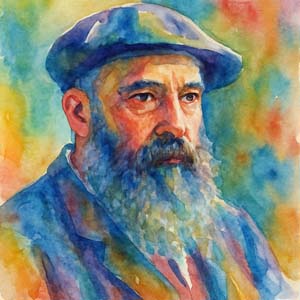— Claude Monet
 French artist Claude Monet (1840–1926) sought to find the perfect fusion of light and subject, capturing the spontaneous impressions of nature. His 1874 painting, Impression, Sunrise, gave the Impressionist movement its name.
French artist Claude Monet (1840–1926) sought to find the perfect fusion of light and subject, capturing the spontaneous impressions of nature. His 1874 painting, Impression, Sunrise, gave the Impressionist movement its name.
“Light is the most important person in the picture,” he explained.
The son of a grocer, Monet began painting outdoors at 18. “Suddenly,” he said, “a veil was torn away. I had understood—I had realized what painting could be.”
He painted simple landscapes, seascapes, and river scenes with subtle harmonies. As his style developed, he violated one artistic convention after another, experimenting with sunlight and the direct, sketch-like application of bright color.
“I am following Nature without being able to grasp her... I perhaps owe having become a painter to flowers,” he said. With confidence, he painted as if seeing the world for the first time.
“No one is an artist unless he carries his picture in his head before painting it, and is sure of his method and composition.”
At Giverny, a small village northwest of Paris, he cultivated a garden that would inspire him for forty years. Zinnias, fuchsias, hollyhocks, daisies—all flourished under his care and spiritual grace.
The water lilies were his greatest prize. He painted their beauty in every season, exploring light and atmosphere.
One art dealer, overwhelmed by a Monet, described it as “neither beginning nor end. It is mysterious, delightfully unreal.”
 Celebrate the joy in your life!
Celebrate the joy in your life!
